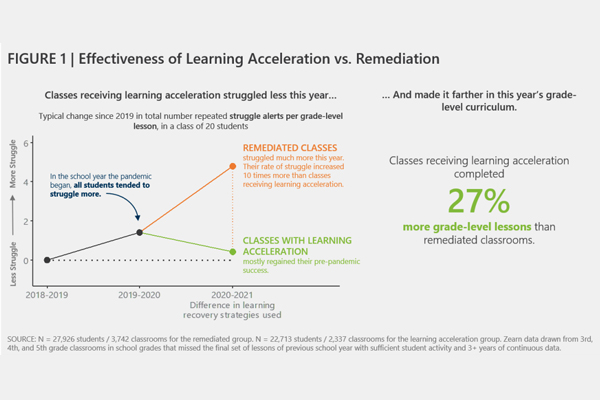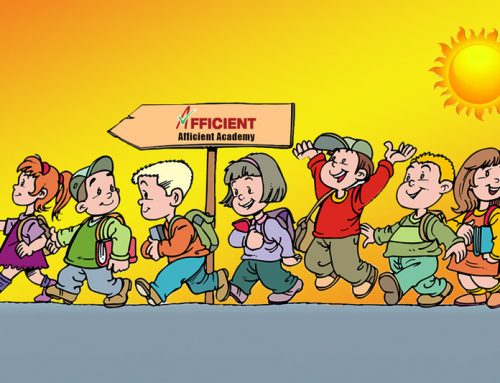The COVID-19 pandemic has required many industries to experiment with new and innovative approaches to serving the needs of the public. The education industry is no exception. The 2020/2021 school year was tumultuous, to say the least, and incessant disruptions widely impacted student learning. Indeed, K-12 students began the 2021/2022 school year an average of five months behind grade level in mathematics and four months behind in reading. With schools reopening and in-person instruction largely resumed, school systems are left with the momentous task of closing these widespread learning gaps as soon as possible to prevent long-term educational inequities.
But what is the best way to fill in these learning gaps and bring students to grade level by the end of this year? A recent study by TNTP (The New Teacher Project) and ZEARN (an educational nonprofit) posed the following question: Is remediation or acceleration the best approach to closing the COVID-19 learning gap?
Remedial Learning

Remedial teaching is the traditional approach to addressing learning gaps in K-12 education. Groups of students behind grade level are required to re-learn skills from previous units or grades PRIOR to exposure to on-level content. For example, a second-grade remedial grammar class would have students learn all grammar standards for first grade BEFORE learning on-level, second-grade standards. While this makes sense logically, the reality is often that student learning does not accelerate but remains stagnant. Thus, if students begin the academic year at a mid-first-grade level, they will end the year on their summative tests at a mid-second-grade level. Rather than leveling the playing field, the student will likely be tracked into remedial classes year after year, with learning gaps steadily widening over time. This is how long-term educational equities are created, which often disproportionately impact students of color and low-income communities. We cannot afford to see widespread learning gaps from events like COVID-19 impact students for years to come.
Accelerated Education

This brings us to Learning Acceleration. Accelerated learning involves covering all of the grade-level standards and objectives within an academic year and addressing learning gaps strategically along the way. Thus, if a second-grade student is behind in their grammar knowledge, the instructor will address gaps at the most appropriate time during the grammar conventions sequence. For example, second-grade students must learn how to use collective nouns (e.g., a flock of birds). Before learning this skill, students need to know how to use common nouns (e.g., birds). A teacher committed to accelerated learning would introduce a lesson on using collective nouns by FIRST reminding the students of what a common noun is and its function in a sentence, using that prior knowledge to introduce the NEW concept of collective nouns. This way, the teacher is “scaffolding,” or supporting students with learning gaps while also meeting the needs of students ready for exposure to on-level content. The 2021 study by TNTP and ZEARN found that students exposed to learning acceleration struggled less than their peers exposed to remediation in their math education. In fact, classrooms that utilized learning acceleration completed 27% more grade-level lessons than their remedial counterparts. In particular, learning acceleration positively impacted students of color and low-income communities. This shows that learning acceleration is a more effective way to address learning gaps and prevent long-term education inequities.
Afficient Academy’s Approach to Learning
At Afficient Academy, we are committed to addressing learning gaps while also exposing students to rigorous, grade-level appropriate content. Our Afficient Math and Afficient English students take a FREE diagnostic test to determine their appropriate instructional levels in math, language arts, and vocabulary. For example, a fourth-grade student could be at a second-grade level in vocabulary knowledge, a third-grade level in language arts, and a fourth-grade level in math. Thus, students will spend more time in remediation in subject areas where they need the most attention and have the opportunity to accelerate their learning beyond grade-level expectations when they are ready. Our patented algorithm enables students to catch up to grade level at their own pace, often faster than they would in the traditional classroom. Thus, a student who begins a grade level or two below in vocabulary can catch up to their peers and make the transition from remediation to acceleration in a matter of months.
[Insert appropriate graph from an anonymous student to illustrate how acceleration works]
Afficient Academy’s class-paced math program is our newest experiment in marrying remediation and acceleration. Current 5th- and 6th-grade students can take our diagnostic test to determine whether they would thrive in our Fall 2021 accelerated math programs. If your 5th-grade student tests at a 4th-grade level in math, they can have the opportunity to participate in this accelerated program while also mastering necessary 4th-grade material. Interested in learning more about Afficient Academy’s self-paced and class-paced programs? Please contact us at 408-726-2245 or send us an email at info@afficienta.com.





